Leather is a versatile and durable material, often used in clothing for its combination of style and longevity. However, it is also prone to staining, and these stains can be particularly stubborn to remove. This guide aims to offer simple yet effective methods to help you get those stubborn leather stains out of your clothes, bringing back their original charm and extending their lifespan.
Understanding Leather Stains
Leather is a durable and versatile material that can be found in clothing items such as jackets, shoes, and handbags. However, one downside to leather is that it can easily get stained. Whether it’s from spilled drinks or accidental encounters with dirt and oil, leather stains can be quite tricky to remove.
In this article, we will discuss the different types of leather stains and how to effectively get them out of your clothes. We will also provide some tips on how to prevent these stains in the first place. [1]
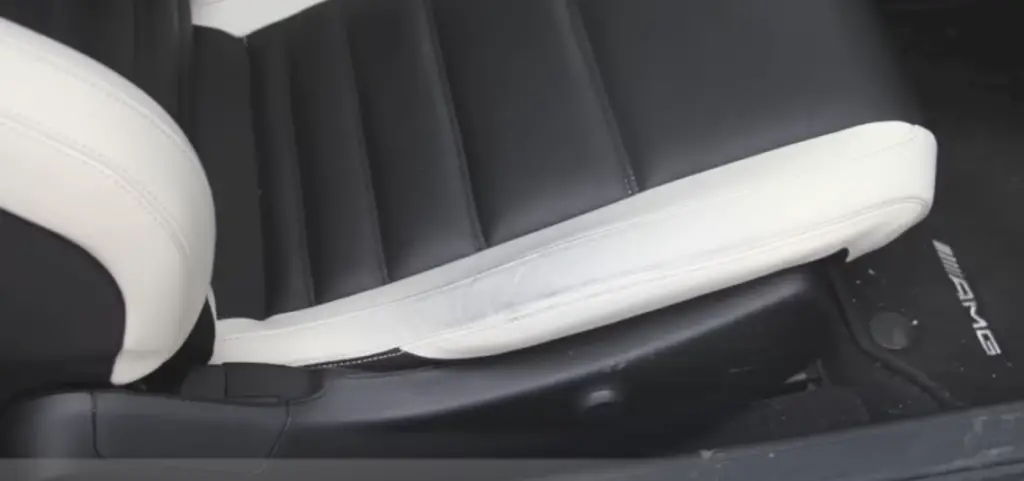
Types of Leather Stains
There are three primary categories of leather stains: oil-based, water-based, and dye transfer. Oil-based stains include grease, makeup, and food oils, while water-based stains consist of liquids like water, juice, and soda. Dye transfer stains happen when the leather comes into contact with other dyed fabrics or materials.
How to Remove Specific Leather Stains
Oil-Based Stains
To remove oil-based stains from leather, you will need to use an absorbent material like baking soda or cornstarch. First, sprinkle the absorbent onto the stained area and let it sit for a couple of hours. Next, delicately sweep away the powder and remove any remaining residue using a moistened cloth.
If the stain continues to persist, you have the option of utilizing a leather cleaner that is specifically formulated for oil-based stains. It is crucial to adhere to the instructions diligently and conduct a preliminary test of the product on an inconspicuous area to ensure optimal results.
Water-Based Stains
To tackle water-based stains, begin by blotting the affected area with a clean cloth or paper towel to soak up excess liquid. Refrain from rubbing or scrubbing, as this can lead to further stain spreading. Then, create a solution by mixing a small amount of mild soap with water and gently dab the stain using a sponge or cloth. Rinse the area thoroughly with clean water and pat it dry.
If the stain is still noticeable, you may consider using a leather shampoo or conditioner to effectively eliminate it. Ensure that you carefully read and follow the instructions, and conduct a patch test before applying the product to the entire affected area.
Dye Transfer Stains
Removing dye transfer stains can prove challenging, as they entail the migration of color from one material to leather. In such instances, it is advisable to seek guidance from a professional leather cleaner for optimal removal. [2]
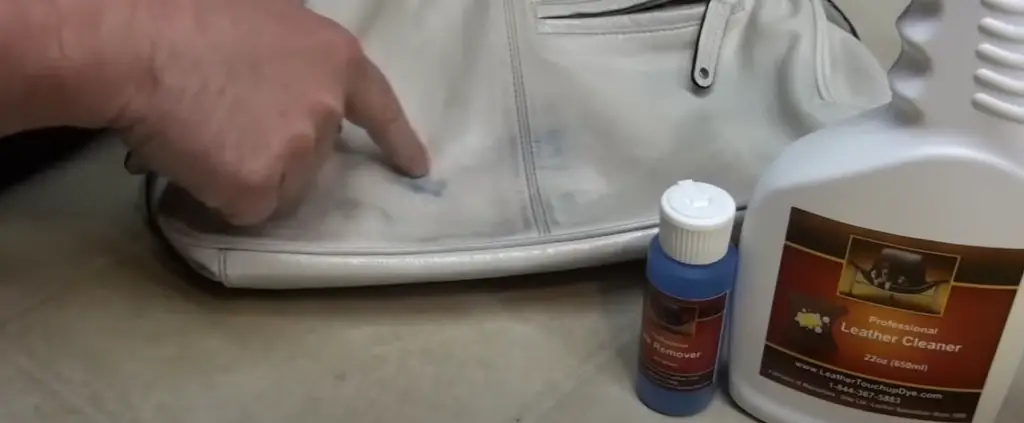
Preventing Leather Stains
Prevention is always better than cure when it comes to leather stains. To avoid getting stains on your clothes, follow these simple tips:
- Be mindful of where you sit or lean. Avoid placing yourself on surfaces that may have dirt, oil or other substances that can transfer onto your clothing.
- Cover your leather items when not in use. This will protect them from dust and potential stains.
- Keep a stain remover handy. In case of accidental spills or stains, having a reliable stain remover can save your leather clothes.
- Be cautious when using chemicals. Some cleaning products or beauty products may contain ingredients that can cause stains on leather, so always read labels and test on a small inconspicuous area first.
Causes of Leather Stains
Leather stains can occur due to various reasons, such as:
- Spills from food or drinks with dark colors or high acidity levels.
- Exposure to oils or greasy substances.
- Contact with strong dyes or inks.
- Perspiration and body oils.
- Incorrect cleaning methods or products.
Knowing the potential causes of leather stains can help you take preventive measures and avoid them in the future.
Professional Cleaning Services for Leather Stains
If all your efforts to remove the stains from your leather clothes have failed, it may be time to seek professional help. Professional cleaning services have the expertise and specialized products to effectively remove tough stains without damaging your leather items. They also have advanced techniques such as steam cleaning or dry cleaning for more delicate types of leather. However, keep in mind that these services can be costly, so it’s best to exhaust all other options before resorting to them. [3]
Dealing with Ink and Dye Stains
Ink and dye stains can be one of the most stubborn types of stains to remove from clothes. Whether it’s a pen leaking in your pocket or a dye transfer from another garment, getting rid of these stains can be a challenge. However, with the right techniques and products, you can successfully remove ink and dye stains from your clothes.
Pre-treating the Stain
The first step in removing ink and dye stains is to pre-treat the affected area. This will help loosen the stain before you wash your clothes. There are several household products that can be effective in pre-treating these types of stains, including:
- Rubbing alcohol: Soak a cotton ball or cloth in rubbing alcohol and dab it on the stain. Let it sit for a few minutes before washing.
- White vinegar: Mix equal parts of white vinegar and water, then blot the stain with the solution.
- Hydrogen peroxide: Soak the stain in hydrogen peroxide for a few minutes before washing.
Be sure to spot test any product on an inconspicuous area of your clothes first to ensure it won’t cause further damage.
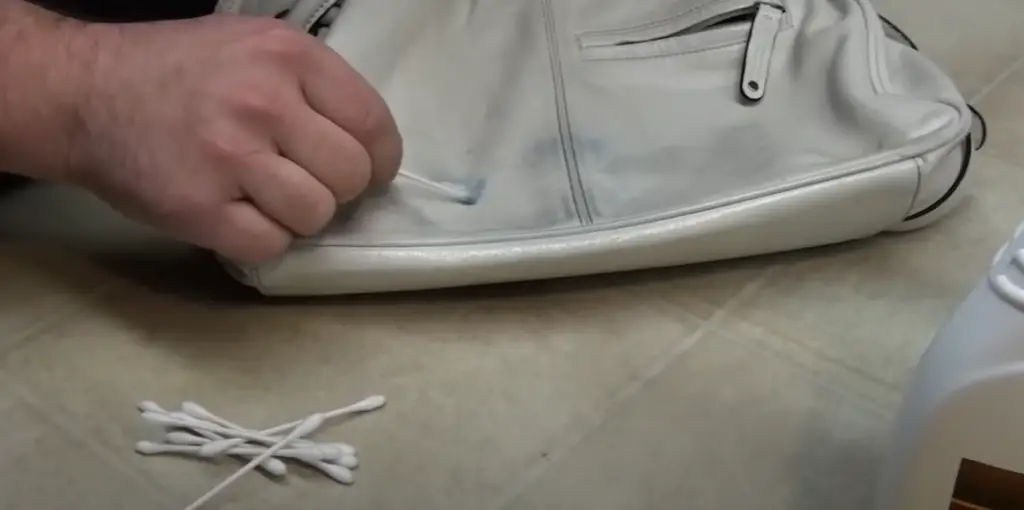
Washing Your Clothes
After pre-treating the stain, it’s important to wash your clothes as soon as possible. Use a high-quality detergent and follow the care instructions on the garment’s label. If the stained item is white, you can also add bleach to the wash cycle for an extra boost in stain removal.
If the stain persists after washing, try repeating the pre-treatment process and washing again. [4]
What Happens to Leather in Washing Machines?
Leather is a delicate material and should not be washed in a washing machine. The agitation, high heat and detergents used in washing machines can damage the leather and cause it to lose its natural oils and texture.
If your leather garment is heavily soiled, it’s best to take it to a professional cleaner who specializes in leather care. They have the knowledge and equipment necessary to properly clean and treat leather without causing damage.
Can Rubbing Alcohol Remove Leather Dye?
Rubbing alcohol, also known as isopropyl alcohol, is a common household solvent that can be used for a variety of cleaning purposes. It is commonly used to remove stains and disinfect surfaces due to its ability to dissolve oils and dirt.
When it comes to removing leather dye stains from clothes, rubbing alcohol may seem like an effective solution. However, before attempting to use it on your clothes, it is important to understand the potential risks and limitations associated with using rubbing alcohol as a stain remover for leather dye. [5]
Does Bleach Remove Leather Dye?
Bleach is a popular household product used for removing stains and brightening whites. However, when it comes to leather, bleach can cause more harm than good. While bleach may be effective in removing some types of stains on leather, it can also remove the dye from the leather itself.
Leather dye is much different than fabric or hair dye. It penetrates deep into the pores of the leather, resulting in a long-lasting color. When bleach is applied to leather, it can strip away this dye and leave behind a discolored spot or patch on the material.
In addition to removing dye, bleach can also weaken the fibers of the leather, making it more susceptible to damage and tearing. This means that using bleach on leather clothing or accessories can actually ruin the item rather than cleaning it.
So, if you’re wondering whether bleach is a safe option for removing leather stains, the answer is no. It’s important to use gentle and specialized cleaners designed for leather materials in order to effectively and safely remove stains without damaging the dye or fabric itself.
If you do happen to accidentally get bleach on your leather clothing or accessories, it’s best to act quickly and try to remove the bleach with a damp cloth. Then, follow up with a leather cleaner or conditioner to help restore the color and moisture of the leather. [6]
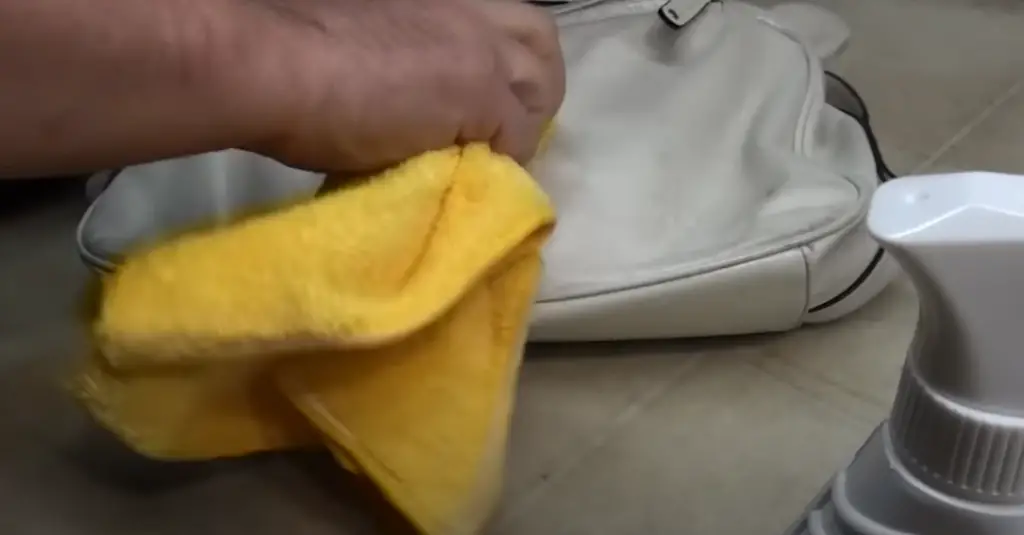
FAQs
What are the common types of leather stains?
The most common types of leather stains are oil, ink, dye, and food stains. Each type requires a different approach for removal.
Can I use the same techniques for removing stains on all types of fabric?
No, some fabrics may require specific stain removal methods due to their delicate nature or color-fastness. It’s always best to check the care instructions on the garment before attempting to remove a stain. In general, it’s recommended to treat stains as soon as possible for best results.
How can I prevent ink and dye stains on my clothes?
To prevent ink and dye stains, be cautious when using pens or markers near your clothing. You can also try wearing an apron while cooking or handling potentially staining materials. Additionally, sorting your laundry by color can help prevent dye transfers from occurring in the wash. Keep a stain remover or pre-treating product on hand for any potential accidents.
Are there any special products available for leather stain removal?
Yes, there are special leather stain removal products available on the market. It’s important to read the instructions carefully and test them on an inconspicuous area first before using on the entire stained area. If you’re unsure about using a product, it’s best to consult a professional cleaner for advice.
How should I apply a leather stain remover?
For best results, carefully follow the instructions on the product. In general, you will need to apply the stain remover onto a clean cloth and gently rub it onto the stained area in a circular motion. Allow it to sit for a few minutes before wiping off with a clean damp cloth. Repeat if necessary. Always test on an inconspicuous area first and avoid saturating the leather. It’s also recommended to condition the leather after using a stain remover to keep it looking its best. If in doubt, consult a professional cleaner for advice on how to properly treat your specific type of leather.
What precautions should I take when trying to remove leather stains?
When attempting to remove leather stains, it’s important to use caution and follow the instructions carefully. Avoid using harsh chemicals or scrubbing vigorously, as this can cause damage to the leather. If you’re unsure about how to handle a stain, it’s always best to consult a professional cleaner for guidance. Additionally, always spot test any product on an inconspicuous area first to ensure it won’t cause further damage.
Can all leather stains be removed, or are some permanent?
It depends on the type of stain and the age of the leather. The sooner you can treat a stain, the better chance you have at removing it completely. Older stains or certain types of stains (such as oil) may be more difficult to remove and could potentially be permanent. It’s best to take action as soon as possible when dealing with any type of stain on leather. If in doubt, consult a professional cleaner for advice on the best course of action. Remember to always test any products or methods on a small, inconspicuous area first before treating the entire stain.
How can I prevent stains on leather clothes?
To prevent stains on leather clothes, it’s important to use caution when wearing them and handle any potential staining materials with care. It’s also a good idea to treat your leather items with a protective spray or conditioner before wearing them, as this can help repel stains. Avoid exposing your leather clothing to extreme temperatures or moisture, as this could cause damage. It’s also a good idea to clean and condition your leather items regularly to keep them in top shape. If you’re unsure about how to properly care for your specific type of leather, consult a professional cleaner for advice.
Does leather dye bleed?
Yes, leather dye can bleed onto clothes and other materials. This is especially common with new or untreated leather items, as the dye may not have fully set or been sealed properly. However, even with older and well-treated leather products, some bleeding of the dye may still occur.
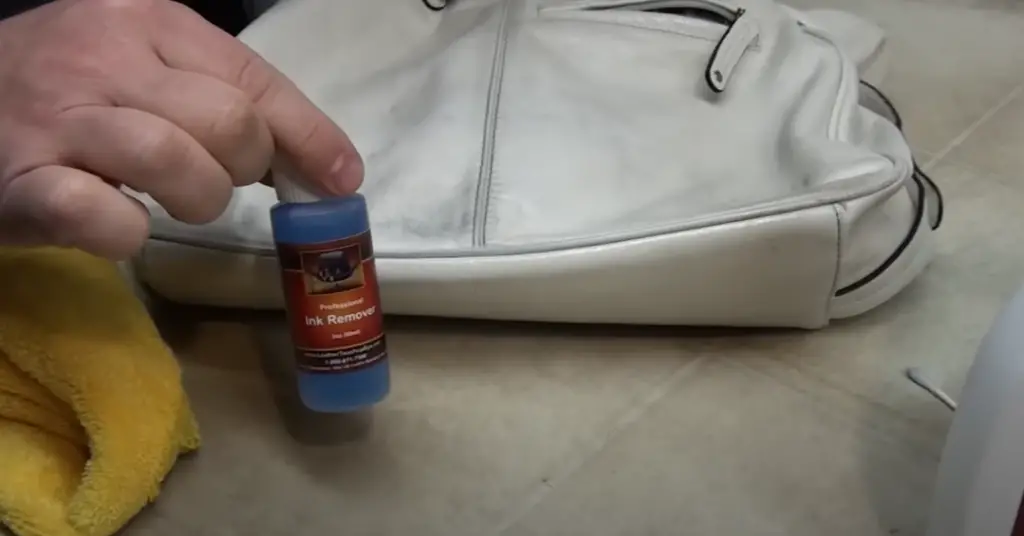
How do you prevent leather dye from bleeding?
To prevent leather dye from bleeding onto your clothes or other materials, it is important to properly treat and seal your leather items before use. This can include using a protective spray or wax, or having your item professionally sealed. Additionally, be sure to check the care instructions for any leather products before washing them, as improper cleaning methods can also cause dye bleeding.
What should I do if home remedies and commercial products don’t work?
In some cases, stains on leather may be difficult to remove even with home remedies and commercial products. If you’ve tried multiple methods without success, it’s best to seek the help of a professional cleaner who has experience in treating leather stains. They will have access to specialized products and techniques that can effectively remove stubborn stains without causing damage to the leather. Additionally, they can offer advice on how to prevent future stains and properly care for your leather items. Remember, it’s always better to seek professional help than risk causing further damage to your valuable clothing items.
Useful Video: How to Clean Leather
Conclusion
In conclusion, removing leather stains from clothes can be a challenging task but it is definitely not impossible. With the right techniques and products, you can restore your stained clothes to their former glory.
However, prevention is always better than cure. It’s important to take necessary precautions to avoid getting leather stains on your clothes in the first place. This includes being careful while wearing leather items and avoiding contact with potential stain-causing substances.
In addition, it’s always a good idea to regularly clean and condition your leather items to prevent any potential transfer of stains onto your clothes.
If you do happen to get a leather stain on your clothes, remember to act quickly and follow the appropriate steps based on the type of stain. And if all else fails, don’t be afraid to seek professional help.
Remember, with a bit of knowledge and effort, you can successfully remove leather stains from your clothes and keep them looking clean and pristine. So don’t let those pesky stains ruin your favorite outfit – take action and say goodbye to leather stains for good!
References:
- https://lifehacks.stackexchange.com/questions/17273/how-can-i-remove-leather-dye-stains-from-colored-clothing
- https://www.leathercraftgarage.com/get-leather-dye-out-of-clothes/
- https://www.askandyaboutclothes.com/threads/leather-dye-stain-on-white-dress-shirt.115919/
- https://www.furnitureclinic.com/leather-stain-remover
- https://www.thespruce.com/remove-dye-transfer-stains-from-clothes-2146658
- https://octaneseating.com/blog/leather-stain-removal/


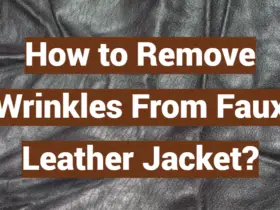





Leave a Reply